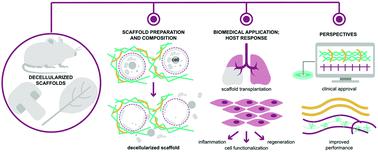当前位置:
X-MOL 学术
›
J. Mater. Chem. B
›
论文详情
Our official English website, www.x-mol.net, welcomes your
feedback! (Note: you will need to create a separate account there.)
Bioreactivity of decellularized animal, plant, and fungal scaffolds: perspectives for medical applications
Journal of Materials Chemistry B ( IF 6.1 ) Pub Date : 2020-10-16 , DOI: 10.1039/d0tb01751e Aleksandra L. Predeina 1, 2, 3, 4 , Marina S. Dukhinova 1, 2, 3, 4 , Vladimir V. Vinogradov 1, 2, 3, 4
Journal of Materials Chemistry B ( IF 6.1 ) Pub Date : 2020-10-16 , DOI: 10.1039/d0tb01751e Aleksandra L. Predeina 1, 2, 3, 4 , Marina S. Dukhinova 1, 2, 3, 4 , Vladimir V. Vinogradov 1, 2, 3, 4
Affiliation

|
Numerous biomedical applications imply supportive materials to improve protective, antibacterial, and regenerative abilities upon surgical interventions, oncotherapy, regenerative medicine, and others. With the increasing variability of the possible sources, the materials of natural origin are among the safest and most accessible biomedical tools. Animal, plant, and fungal tissues can further undergo decellularization to improve their biocompatibility. Decellularized scaffolds lack the most reactive cellular material, nuclear and cytoplasmic components, that predominantly trigger immune responses. At the same time, the outstanding initial three-dimensional microarchitecture, biomechanical properties, and general composition of the scaffolds are preserved. These unique features make the scaffolds perfect ready-to-use platforms for various biomedical applications, implying cell growth and functionalization. Decellularized materials can be repopulated with various cells upon request, including epithelial, endothelial, muscle and neuronal cells, and applied for structural and functional biorepair within diverse biological sites, including the skin and musculoskeletal, cardiovascular, and central nervous systems. However, the molecular and cellular mechanisms behind scaffold and host tissue interactions remain not fully understood, which significantly restricts their integration into clinical practice. In this review, we address the essential aspects of decellularization, scaffold preparation techniques, and its biochemical composition and properties, which determine the biocompatibility and immunogenicity of the materials. With the integrated evaluation of the scaffold profile in living systems, decellularized animal, plant, and fungal scaffolds have the potential to become essential instruments for safe and controllable biomedical applications.
中文翻译:

去细胞动植物,真菌支架的生物反应性:医学应用前景
许多生物医学应用暗示支持材料可在外科手术,肿瘤治疗,再生医学及其他方面提高保护,抗菌和再生能力。随着可能来源可变性的增加,天然来源的材料已成为最安全和最容易获得的生物医学工具。动物,植物和真菌组织可以进一步脱细胞以提高其生物相容性。去细胞支架缺乏最活泼的细胞物质,核和细胞质成分,主要触发免疫反应。同时,保留了杰出的初始三维微结构,生物力学性能和支架的一般组成。这些独特的功能使支架成为各种生物医学应用的理想即用平台,暗示细胞生长和功能化。脱细胞材料可以根据要求重新填充各种细胞,包括上皮细胞,内皮细胞,肌肉和神经元细胞,并用于各种生物部位(包括皮肤和肌肉骨骼,心血管和中枢神经系统)的结构和功能生物修复。然而,支架和宿主组织相互作用背后的分子和细胞机制仍未完全了解,这极大地限制了它们整合到临床实践中。在这篇综述中,我们讨论了脱细胞,支架制备技术及其生化组成和性质的基本方面,决定了材料的生物相容性和免疫原性。通过对生命系统中支架轮廓的综合评估,脱细胞的动物,植物和真菌支架有可能成为安全可控生物医学应用中必不可少的工具。
更新日期:2020-11-03
中文翻译:

去细胞动植物,真菌支架的生物反应性:医学应用前景
许多生物医学应用暗示支持材料可在外科手术,肿瘤治疗,再生医学及其他方面提高保护,抗菌和再生能力。随着可能来源可变性的增加,天然来源的材料已成为最安全和最容易获得的生物医学工具。动物,植物和真菌组织可以进一步脱细胞以提高其生物相容性。去细胞支架缺乏最活泼的细胞物质,核和细胞质成分,主要触发免疫反应。同时,保留了杰出的初始三维微结构,生物力学性能和支架的一般组成。这些独特的功能使支架成为各种生物医学应用的理想即用平台,暗示细胞生长和功能化。脱细胞材料可以根据要求重新填充各种细胞,包括上皮细胞,内皮细胞,肌肉和神经元细胞,并用于各种生物部位(包括皮肤和肌肉骨骼,心血管和中枢神经系统)的结构和功能生物修复。然而,支架和宿主组织相互作用背后的分子和细胞机制仍未完全了解,这极大地限制了它们整合到临床实践中。在这篇综述中,我们讨论了脱细胞,支架制备技术及其生化组成和性质的基本方面,决定了材料的生物相容性和免疫原性。通过对生命系统中支架轮廓的综合评估,脱细胞的动物,植物和真菌支架有可能成为安全可控生物医学应用中必不可少的工具。











































 京公网安备 11010802027423号
京公网安备 11010802027423号